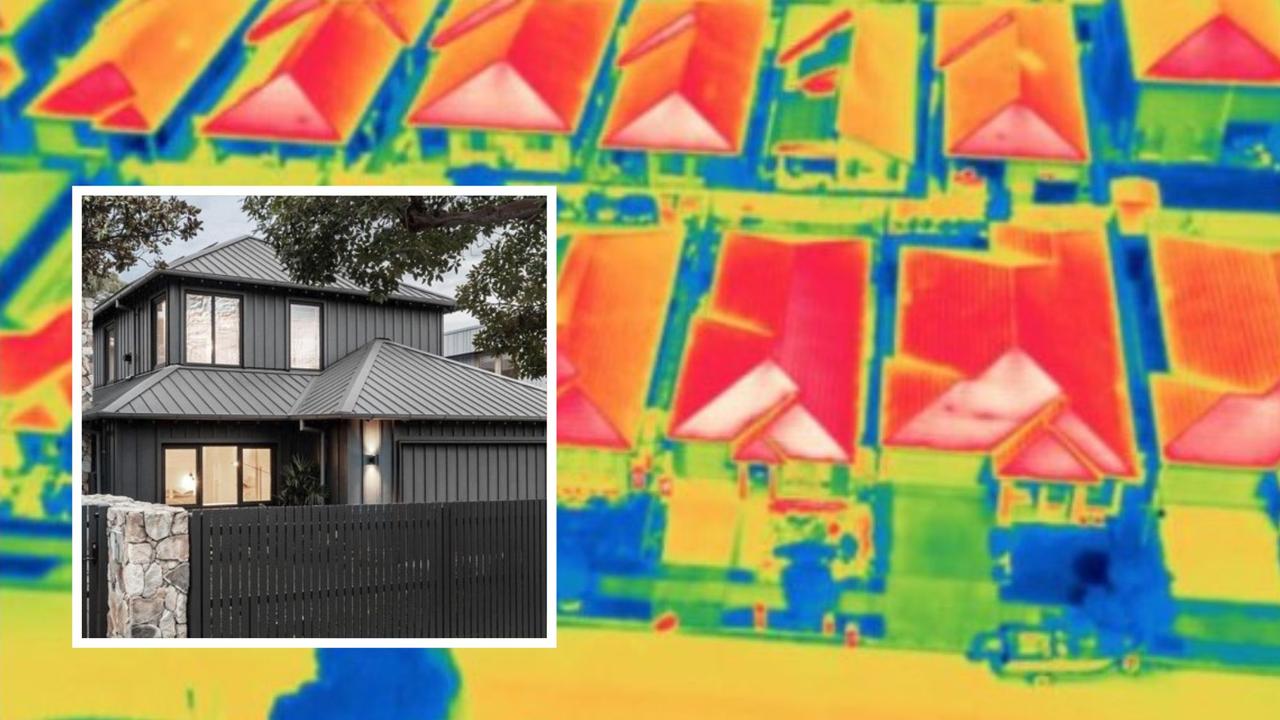An incredibly popular home design trend is facing extinction as authorities and major industry players across the country respond to growing calls for a ban.
From the multimillion-dollar properties on The Block to the glossy pages of design magazines, dark roof colours have taken hold in recent years and become increasingly sought-after.
They’re also extremely common in new suburbs popping up on the fringes of major capitals like Sydney, Melbourne, Brisbane and Adelaide.
But research shows colour matters when it comes to regulating heat – not just inside an individual dwelling, but across entire neighbourhoods.
The Playford Alive urban renewal project in Adelaide’s northern suburbs takes in a mammoth 1000ha state-of-the-art site, including 500ha of housing development.
When eventually complete, the sprawling $1 billion project in Munno Para will be home to some 40,000 people.
Nick Champion, Minister for Housing and Urban Development, said most of the homes built to date have dark-coloured roofs.
But no more. Last week, Mr Champion announced that dark roofs will be eliminated from all future stages of Playford Alive.
“Encouraging the use of light-coloured roofs in home designs helps to reduce temperature fluctuations in the home – lowering electricity bills and minimising the environmental footprint associated with traditional building practices,” Mr Champion said.
“It is imperative that we mitigate any potential urban heat island effect by implementing these changes now, as our infill is built-up to meet housing demands.”
The urban heat island effect describes scenarios where pockets are substantially hotter than nearby areas, resulting in hotter streets, higher daytime temperatures, and lower night-time cooling.
A report by Seed Consulting, which heat-mapped Adelaide’s northern suburbs, found homes with light-coloured roofs were 4.3C cooler on an average day than dark roofed homes.
Janine Strachan, chief executive of the Insulation Council of Australia and New Zealand, praised the Playford Alive decision.
“This initiative of light-coloured roofs, when coupled together with roof blankets and ceiling insulation, will great improve the energy efficiency and comfort factor in these homes,” Ms Strachan said.
In hotter parts of the country, such as Western Sydney, the impact of dark roof colours is much greater.
Research shows a dark roof there can be 40C hotter on its surface than air temperature and experts have noted instances where a roof cavity reaches 50C on a hot day.
“Fifteen or so years back, having a dark-coloured roof became really popular,” city planner Samuel Austin said.
“They look stylish and modern, so people loved them. The problem is, that’s a 150sq m surface sitting in the sun all day attracting and absorbing huge amounts of heat.”
Whole suburbs developed in the past decade, including large chunks of the fringes of Melbourne, Sydney and Adelaide, are covered by a sea of black and dark grey.
“Just about every roof in Western Sydney is black,” Mr Austin said.
Planners and sustainability experts have been lobbying for change for years, but progress has been slow or start-stop.
The New South Wales Government had been working on a fix via a sweeping update to building standards, known as BASIX, aimed at slashing thermal energy use by 20 per cent, reducing heat inside a home and saving residents money on cooling costs.
But in August, the state’s Planning Minister Paul Scully shelved the plan for at least nine months, blaming the cost impact on new builds in the midst of housing and cost-of-living crises.
Experts have savaged the decision, with one saying it leaves people vulnerable to Australia’s “silent killer”.
“They’ve effectively thrown the tools they developed to combat urban overheating in the gutter,” Associate Professor Sebastian Pfautsch from Western Sydney University said.
“It is common knowledge that heat is the silent killer in Australia that costs more lives than those lost in all other natural disasters combined. All credible projections point towards more heat and in the recent past, Western Sydney was already twice the hottest place on the planet.
“The government is knowingly leaving the people of Western Sydney vulnerable to heat.”
In lieu of action at a state level, some councils in Melbourne’s outer suburbs are now starting to take their own initiatives to discourage dark roofs.
Last year, the City of Wyndham on the southwest fringe rolled out revised planning guidelines, which included an end to the black roof trend in its jurisdiction.
Professor Pfautsch called for an “outright” ban on dark roofs across the country, but particularly in Victoria and New South Wales.
Developers and consumers continue opting for materials that amplify urban heat. In a warming area, this development puts lives at risk.
“During a heatwave, when all these dark-roofed suburbs will run their airconditioning systems, the high demand increases the risk of blackouts. And when the AC goes, occupants will be severely impacted by heat.”
He added that if an entire suburb has light-coloured roofs, the ambient air temperature can be reduced by 2C.
Some studies indicate neighbourhoods in particularly hot areas like Western Sydney could be 10C cooler in a heatwave if light roofs were the norm.
Master Builders Association director of policy Kym Morgan said light-coloured roofing “just makes sense”.
“It leads to significantly cooler homes, and that ultimately means less time running air conditioners and lower energy bills,” Mr Morgan said.
“It also means cooler suburbs if consumers adopt lighter roofs en masse.”
